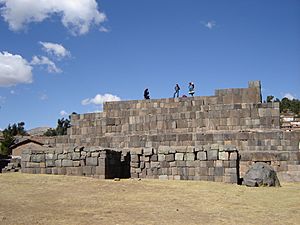Ushnu facts for kids
An ushnu (say: OOSH-noo) was a special pyramid-shaped structure. The Inca people used these structures. They were important for the biggest ceremonies of the Inca Empire.
Contents
What's in a Name?
We don't know much about the old Quechua language meaning of ushnu. It might have meant "the place of stones where water filters." This makes sense because ushnus were good for receiving liquid offerings.
People think ancient groups used them for special offerings. So, the word ushnu probably came to mean "the place where liquids are offered." It was a place for important drinks or offerings.
Pachacuti Ynga ordered many haziendas to sacrifice the uacas and of the houses of the Sun and temple of Coricancha; the throne and asiento seat of the Yngas called usno in every wamani it indicated.
How Ushnus Were Built
An ushnu was usually a rectangular pyramid. It had five flat levels, one above the other. A set of stairs led to the very top. Everything was built from stone.
At the highest point, there was a special stone seat. It was a double armchair. Local stories say this seat was once covered with gold. This was where the Inca ruler and the Coya (his wife) sat. They would make decisions and lead ceremonies. These ceremonies and rituals happened in the main square below. Ushnus were carefully built. They followed rules about how they lined up with the stars.
Ushnus and the Stars
In the city of Cusco, the ushnu was also a place to watch the stars. Experts like Zuidema have shown this. He said the ushnu was the main building in Cusco's square. It helped shape the entire city. This shows that ushnus were important for both ceremonies and astronomy. They also helped design the Inca capital.
The Incas organized space in Cusco using a system called ceques. The Qurikancha temple was the center of this system. Some sacred places (huacas) in the ceques system were used to watch the stars from the ushnu. Many huacas and ceques were linked to specific events in the sky. So, this system was about both directions and stars.
The Inca world was divided into four main directions. These were Northeast, Southeast, Northwest, and Southwest. Each direction had four more star-related directions. In total, there were 20 directions. These were used for planning in the Inca Empire.
Ushnus and the Inca World
The Incas built ushnus to show their view of the world. They believed the world had three main parts:
- Hanan Pacha: The world above, where the gods lived.
- Kay Pacha: The world here, where people lived.
- Uku Pacha: The world below, for the dead and things under the earth.
In the Quechua language, the word pasha means both time and space.
Ushnus connected the world of the living (Kay Pacha) with the worlds above and below. They helped people understand time and space. During ceremonies, the ushnu became like a stage. The Inca ruler stood at the center. This spot connected all the sacred directions. It linked the three worlds and also the idea of time.
The ushnu and its organized space created a powerful scene. This helped everyone feel connected and share the same beliefs. The Incas used ideas from lands they conquered. They used these ideas to make their empire stronger. These new ushnus were like new versions of Cusco. They helped bring different areas together.
The Incas also wanted to link sacred places in conquered lands. They did this through a big ceremony called the Qapaq Ucha. This ceremony connected these places to the ushnus. It also connected them to the entire cosmos. The Qapaq Ucha was likely the biggest Inca ceremony.
How Ushnus Changed
Over time, Inca rituals became more detailed. The ushnu became a place for more than just liquid offerings. It was also used for special offerings, including animals and burning fabrics.
See also
 In Spanish: Ushnu para niños
In Spanish: Ushnu para niños


